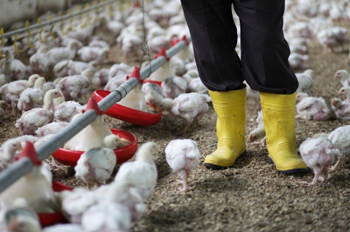Partnerships for Environmental Public Health (PEPH)
Academic Partner:
Johns Hopkins University
Ellen K. Silbergeld, Ph.D.
Community Partners:
Socially Responsible Agriculture Project
Environmental Defense Fund (North Carolina Office)
United Food and Commercial Workers Union
Delmarva Poultry Justice Alliance

Project Description
In regions of intensive food animal production, workers and their communities share risks of exposure to pathogens in the workplace and the associated health impacts from these exposures. The connection between community associated methicillin-resistant Staphylococcus aureus (CA-MRSA) infections and industrial food animal production generally has been overlooked. Workers in food animal industries, their families, and their communities need research-based information about the pathways of infection so they can develop prevention strategies.
Researchers at Johns Hopkins University collaborated with the University of North Carolina School of Public Health, the Socially Responsible Agriculture Project, the North Carolina Office of the Environmental Defense Fund, the United Food and Commercial Workers Union, the Rural Empowerment Association for Community Help, and the Delmarva Poultry Justice Alliance to identify geographic and social networks that link workers and communities and to define points of intervention to reduce the risks of CA-MRSA exposure among slaughterhouse and farm workers and community members. This was the first study to focus on the spread of MRSA infections from workers in food animal production to members of the surrounding community. This partnership sought to empower workers and their communities to act to reduce the spread of CA-MRSA among farmers, farm workers, and surrounding communities.
The project partners:
- Investigated the prevalence of MRSA among workers and community residents, finding that although prevalence of S. aureus and methicillin-resistant S. aureus (MRSA) was similar in hog slaughter/processing plant workers and their household and community members, S. aureus isolates from workers were resistant to a greater number of antimicrobial classes.
- Designed informational materials to communicate with food production workers, farmers, farm workers, and community members. This information served as the foundation to support individual and community action to limit transmission of the pathogen from the work environment to the community.
An evaluation measured uptake of the outreach message, empowerment of stakeholders, and efficacy of policies and identified knowledge gaps for public health actions.
This project was funded by the National Institute for Occupational Safety and Health.
Selected Publications:
- Neyra RC, Frisancho JA, Rinsky JL, Resnick C, Carroll KC, Rule AM, Ross T, You Y, Price LB, Silbergeld EK. 2014. Multidrug-resistant and methicillin-resistant Staphylococcus aureus (MRSA) in hog slaughter and processing plant workers and their community in North Carolina (USA). Environ Health Perspect 122(5):471-477. [Abstract Neyra RC, Frisancho JA, Rinsky JL, Resnick C, Carroll KC, Rule AM, Ross T, You Y, Price LB, Silbergeld EK. 2014. Multidrug-resistant and methicillin-resistant Staphylococcus aureus (MRSA) in hog slaughter and processing plant workers and their community in North Carolina (USA). Environ Health Perspect 122(5):471-477.]
- Davis MF, Price LB, Liu CM, Silbergeld EK. 2011. An ecological perspective on U.S. industrial poultry production: the role of anthropogenic ecosystems on the emergence of drug-resistant bacteria from agricultural environments. Curr Opin Microbiol 14(3):244-250. [Abstract Davis MF, Price LB, Liu CM, Silbergeld EK. 2011. An ecological perspective on U.S. industrial poultry production: the role of anthropogenic ecosystems on the emergence of drug-resistant bacteria from agricultural environments. Curr Opin Microbiol 14(3):244-250.]
- Feingold BJ, Vegosen L, Davis M, Leibler J, Peterson A, Silbergeld EK. 2010. A niche for infectious disease in environmental health: rethinking the toxicological paradigm. Environ Health Perspect 118(8):1165-1172. [Abstract Feingold BJ, Vegosen L, Davis M, Leibler J, Peterson A, Silbergeld EK. 2010. A niche for infectious disease in environmental health: rethinking the toxicological paradigm. Environ Health Perspect 118(8):1165-1172.]


